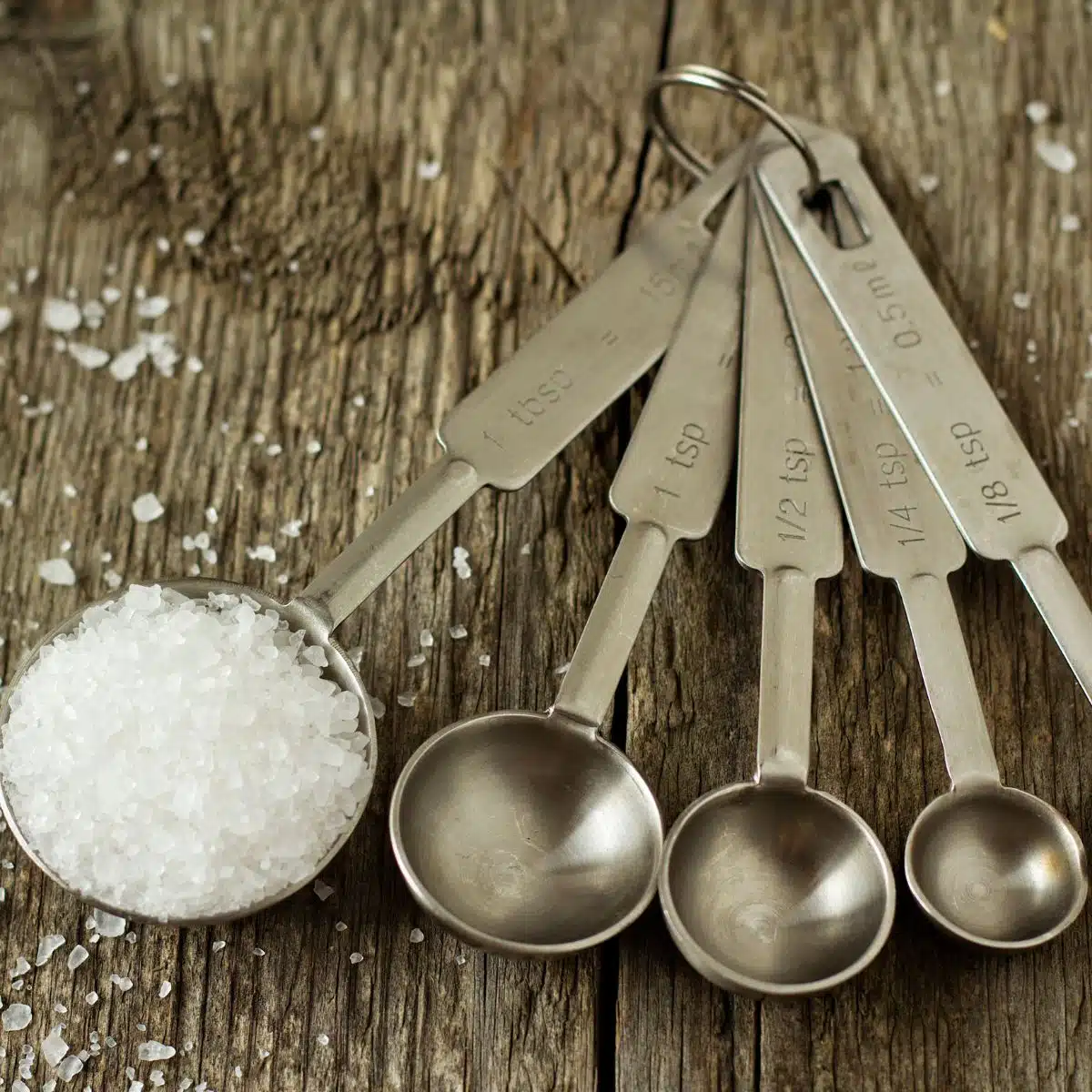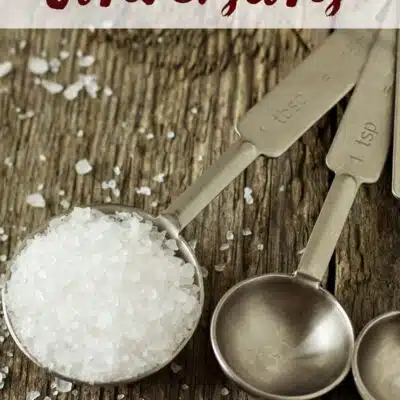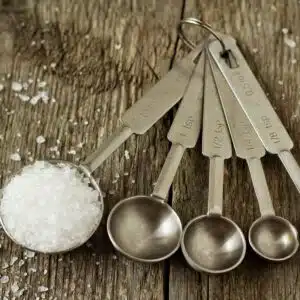These salt conversions will easily be able to help you out when you're in the kitchen and need to swap out the type of salt you're using. I will go over some common types of salt and how to exchange them with one another. You'll never have to worry about an overly salty dish again!

Jump to:
- Converting Different Types of Salt
- Different Kinds of Salt
- 1. Table Salt
- 2. Kosher Salt
- 3. Sea Salt
- 4. Himalayan Pink Salt
- 5. Pickling Salt
- Kosher Salt vs. Himalayan Salt
- Volume vs. Weight
- Table 1. Salt Substitutions
- Table 2. Salt Conversions
- Tips For Converting Salt
- More Measurement Conversions
- 📖 Recipe Card
- 💬 Comments & Reviews
Converting Different Types of Salt
If you've ever been preparing a recipe and realized it calls for a type of salt that you don't have, you aren't alone! However, you can't just exchange any type of salt in an even swap, so it is important to understand how to convert them!
Different Kinds of Salt
There are many different varieties of salt out there, but today I am going to break down some of the most commonly used varieties and what makes them different from one another.
1. Table Salt
Table salt is the most common type of salt that most people have at home. It is the densest salt variety, meaning it has the saltiest flavor. Many types of table salt contain added potassium iodide (hence why you'll see them labeled as iodized salt) and include non-caking agents.
- Grain Size: Very fine.
- Salinity: Highly concentrated; a small amount goes a long way.
- Conversion: The standard measurement, so no conversion is needed.
2. Kosher Salt
Kosher salt has larger crystals, dissolves quickly, and is not excessively salty in flavor. While it is easy to find at the store, there are actually two different types: Morton's kosher salt and Diamond kosher salt.
These two brands make their kosher salt using a different process and, as a result, have a different outcome. Morton's appears as thin flakes, while Diamond kosher salt looks more like a pyramid. Because of this, Morton's salt does taste saltier when compared to the same volume.
Since these two types of Kosher salt can vary, it is best to measure them by weight for the most accuracy.
- Grain Size: Coarse.
- Salinity: Less salty by volume than table salt due to the larger crystals.
- Conversion: Generally, you'll need to use about 1.25 to 1.5 times the amount of Kosher salt to replace table salt. However, this can vary between brands of Kosher salt, so check the specific packaging for conversion details.
- 1 teaspoon table salt = 1.25 to 1.5 teaspoons Kosher salt.
3. Sea Salt
Sea salt is created from evaporated salt water. This variety of salt typically contains trace amounts of minerals, sediment, and bacteria, which can affect the color of the salt. The level of coarseness can vary.
- Grain Size: Fine or coarse.
- Salinity: Similar to table salt.
- Conversion: The conversion rate is very similar to 1:1 with table salt but is not exact in higher measurements, so refer to the chart below for exact amounts.
- 1 teaspoon table salt = 1 teaspoon sea salt.
4. Himalayan Pink Salt
Himalayan pink salt is a form of rock salt that is used in cooking. It can be used as a large slab or processed into either coarse or fine granules. The pink color comes from small amounts of iron oxide, which contributes a slightly sweet flavor.
- Grain Size: Varies, but often coarser than table salt.
- Salinity: Similar to table salt, but some trace minerals might affect flavor slightly.
- Conversion: Generally, the conversion rate is close (but not exact) to 1:1 with table salt, especially if finely ground. If it's coarser, you may need to use a bit more.
- 1 teaspoon table salt = 1 teaspoon finely ground Himalayan salt (adjust if using coarser crystals). *Note that the conversion is not exactly 1:1, so see the conversion table below for details.
5. Pickling Salt
Pickling salt (or canning salt) is really just regular salt (commonly Kosher salt) that does not include any anti-caking agents. Many brands of salt use anti-caking agents, which is completely fine for consumption.
However, when pickling or canning, you want to avoid these additions because they will cause your brine to look cloudy or will discolor what you're pickling. You can use other varieties of salt for pickling and canning; just make sure it does not include anti-caking agents first.
- Grain Size: Fine.
- Salinity: Less salty by volume than table salt due to the larger crystals.
- Conversion: Pickling salt can be used in a 1:1 swap for table salt.
- 1 teaspoon table salt = 1 teaspoon of pickling salt.
Kosher Salt vs. Himalayan Salt
Kosher salt is distinctly white, like our standard table salt. The flavor of Kosher and table salt is a pure salt flavor, and both are primarily composed of sodium chloride.
Himalayan salt varies in shades of pink, from nearly white or off-white to deeply pink. This is due to the ancient oceans that the salt is mined from and the algae, bacteria, and minerals that reside in the salt. Himalayan salt offers trace amounts of minerals that our bodies need, and these minerals affect the taste profile of the salt.
Volume vs. Weight
When measuring salt (or many other ingredients), there are 2 different ways to do so: either by weight (grams, ounces, etc.) or by volume (cups, teaspoons, etc.). Since different varieties of salt take up different amounts of volume (due to variances in crystal size), you cannot swap them all out in a 1:1 exchange.
For the most accuracy, you can always use a kitchen scale to weigh your salt. When using weight, you can easily exchange your salt while ensuring it weighs the same, and you won't have to worry about adding too much to your recipes.
Table 1. Salt Substitutions
| If the recipe calls for | Appropriate substitutions |
|---|---|
| Table salt | Fine Himalayan Salt, Fine Sea Salt, Canning & Pickling Salt |
| Kosher salt | Coarse Sea Salt (for making dry rubs), Coarse Himalayan Pink Salt (for making dry rubs), Fine Sea Salt, Canning & Pickling Salt (for making brines) |
| Coarse sea salt | Kosher Salt, Coarse Himalayan Pink Salt |
| Fine sea salt | Table Salt, Fine Himalayan Pink Salt, Canning & Pickling Salt |
| Coarse Himalayan pink salt | Kosher Salt (for making dry rubs), Coarse Sea Salt |
| Fine Himalayan pink salt | Fine Sea Salt |
| Natural sea salt | Fine Sea Salt, Fine Himalayan Pink Salt, Table Salt, Canning & Pickling Salt |
| Canning & pickling salt | Natural Sea Salt, Fine Sea Salt, Kosher Salt *Make sure no anti-caking agents are used |
Table 2. Salt Conversions
| Table Salt | Coarse Kosher Salt | Fine Sea Salt | Coarse Sea Salt | Fine Himalayan Pink Salt | Coarse Himalayan Pink Salt | Canning & Pickling Salt |
|---|---|---|---|---|---|---|
| ¼ tsp | ¼ tsp | ¼ tsp | ¼ tsp | ¼ tsp | ¼ tsp | ¼ tsp |
| 1 tsp | 1¼ tsp | 1 tsp | 1 tsp | 1 tsp | 1 tsp | 1 tsp |
| 1 Tbsp | 1 tablespoon + ¾ tsp | 1 Tbsp | 1 Tbsp | 1 tablespoon + ¼ tsp | 1 tablespoon + ¼ tsp | 1 Tbsp |
| ¼ cup | ¼ cup + 1 Tbsp | ¼ cup + ½ tsp | ¼ cup | ¼ cup + 1 tsp | ¼ cup + 1½ tsp | ¼ cup |
| ½ cup | ½ cup + 2 Tbsp | ½ cup + 1 tsp | ½ cup + ¼ teaspoon | ½ cup + 2 tsp | ½ cup + 1 Tbsp | ½ cup |
| ¾ cup | ¾ cup + 3 Tbsp | ¾ cup + 1 tsp | ¾ cup + ¼ tsp | ¾ cup + 1 Tbsp | ¾ cup + 4 tsp | ¾ cup |
| 1 cup | 1¼ cups | 1 cup + 1 tsp | 1 cup + ½ tsp | 1 cup + 4 tsp | 1 cup + 2 Tbsp | 1 cup |
Tips For Converting Salt
- Taste as You Go: Salts can differ in flavor and saltiness, even within the same type, so always taste and adjust as needed.
- Consider the Dish: Different salts dissolve and distribute differently. Keep this in mind for things such as baked goods.
- Adjusting for Volume vs. Weight: The above conversions are for volume measurements. If a recipe gives weights, the different densities of these salts mean that the weight conversion might be different. Using a kitchen scale and following weight measurements will provide the most accuracy.
- Finishing: When using salt for finishing, opt for larger, coarser flakes. If using fine salt, it could dissolve and make your dish overly salty.
- Baking: When baking, use fine salts like table salt or fine sea salt.
>>>See All Of My Tasty Recipes Here!<<<
More Measurement Conversions
Now that you know how to convert salt, you'll be ready to go for any recipe! Leave a comment down below, and let me know what you think!
Do you love a recipe you tried? Please leave a 5-star 🌟rating in the recipe card below and/or a review in the comments section further down the page.
Stay in touch with me through social media @ Pinterest, Facebook, Instagram, or Twitter! Subscribe to the newsletter today (no spam, I promise)! Don't forget to tag me when you try one of my recipes!
📖 Recipe Card
Salt Conversions
Ingredients
- table salt
- sea salt
- Kosher salt
- Himalayan salt
- Pickling salt
(Note: 2x or 3x only changes the ingredient list)
Instructions
- Use 1 tablespoon + ¾ teaspoon of Kosher salt for 1 tablespoon of table salt.
- Use 1 tablespoon of sea salt for 1 tablespoon of table salt.
- Use 1 tablespoon + ¼ teaspoon of Himalayan salt for 1 tablespoon of table salt.
- Use 1 tablespoon of Pickling salt for 1 tablespoon of table salt.



Comments
No Comments